Padre Pio's hospital "Casa Sollievo della Sofferenza" (Home for the
Relief of Suffering).
| |
 In 1940 Padre Pio started thinking of a new hospital.
Here he is with dr. Sanvico.
The evening of January 9, 1940 the Home for the relief of suffering was
born.
A tiny committee formed by dr. Kiswarday, dr. Sanguinetti, dr. Sanvico, miss Seits, and Padre Pio, founder, got immediately into
action.
|
| |
 Padre Pio with dr. Sanvico, dr. Sanguinetti
and others. Padre Pio with dr. Sanvico, dr. Sanguinetti
and others.
From the minutes of the first meeting: "It is agreed
that everything undertaken must be subject to Padre Pio's advice."
Padre Pio refused to consider a bank loan.
|
| |
  Padre Pio got from a pocket
a small gold coin which had been given to him and said: "I
want to be the first to make an offering for the Home for the Relief of
Suffering." The coin is displayed
in the museum of Casa Sollievo. Padre Pio got from a pocket
a small gold coin which had been given to him and said: "I
want to be the first to make an offering for the Home for the Relief of
Suffering." The coin is displayed
in the museum of Casa Sollievo. |
| |
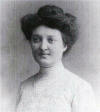 Maria Basilio Venchi, a spiritual daughter,
brought the most part of the land were the future hospital would be
built, and donated it to Padre Pio.
Maria Basilio Venchi, a spiritual daughter,
brought the most part of the land were the future hospital would be
built, and donated it to Padre Pio. |
| |
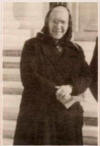 Angela Serritelli,
also spiritual daughter, owned the adjacent part of the land needed for
the hospital. She donated it to Padre Pio.
Angela Serritelli,
also spiritual daughter, owned the adjacent part of the land needed for
the hospital. She donated it to Padre Pio. |
| |
Barbara Ward |
| |
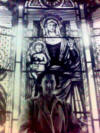 Barbara Ward was an English
journalist and writer for The Economist. She
met Padre Pio in the early stages of the Hospital. Through her boyfriend
Australian Commander Robert Jackson the UNRRA (United Nations Relief
and Rehabilitation Administration)
on June 21, 1948 provided a
very large sum that made possible the construction of the hospital. Barbara Ward was an English
journalist and writer for The Economist. She
met Padre Pio in the early stages of the Hospital. Through her boyfriend
Australian Commander Robert Jackson the UNRRA (United Nations Relief
and Rehabilitation Administration)
on June 21, 1948 provided a
very large sum that made possible the construction of the hospital. |
| |

 Barbara
Ward (front left) visiting the construction site. Angelo Lupi, who
planned and directed the construction, is at far right. Barbara
Ward (front left) visiting the construction site. Angelo Lupi, who
planned and directed the construction, is at far right. |
| |
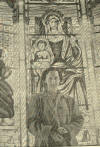 Barbara
asked Padre Pio to pray for the conversion of her boyfriend. Padre Pio
said "yes" and she replied "when?" Padre Pio:
"Even at this moment if
God wants." She later learned that at that very moment he had converted.
She also asked Padre Pio to pray for her recovery from cancer. Barbara
asked Padre Pio to pray for the conversion of her boyfriend. Padre Pio
said "yes" and she replied "when?" Padre Pio:
"Even at this moment if
God wants." She later learned that at that very moment he had converted.
She also asked Padre Pio to pray for her recovery from cancer.
Barbara Ward:
“Padre Pio had downright common sense and
intensely practical attitude towards life. Padre Pio never forgot that
Our Lord not only preached to souls, but also healed bodies. Padre Pio
lived in southern Italy in an area of unrelieved poverty which was the
root of so many neglected diseases, lifelong illnesses, crippling,
blindness, infirmities and miseries. This was the tragic load he had to
deal with from the moment he entered the church at dawn until the last
penitents went on their way.” |
| |
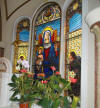    The stained window in the chapel of Casa Sollievo
bears resemblance to Barbara Ward.
The stained window in the chapel of Casa Sollievo
bears resemblance to Barbara Ward. |
| |
The construction of the hospital |
| |
 Padre Pio liked the plans drawn by Angelo Lupi,
and he was put in charge of the construction. Padre Pio liked the plans drawn by Angelo Lupi,
and he was put in charge of the construction. |
| |
 May 19, 1947: Lying of the first stone and
ground braking for the construction of the hospital "Casa Sollievo."
May 19, 1947: Lying of the first stone and
ground braking for the construction of the hospital "Casa Sollievo."
Padre Pio:
"Here will
stand one of the largest centers for the cure of the human ailments." |
| |

 

It was a challenging task to level the slopes of
the mountain at the side of the church and convent.
The construction progressed steadily. |
| |

 Padre Pio (in the car) visited frequently.
Padre Pio (in the car) visited frequently. |
| |







Padre Pio celebrated Mass and made a speech on the
day of the grand opening on May 5, 1956. |
| |










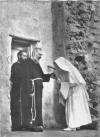
The New York Times: "One of the most
beautiful and most modern hospitals in the world."
Padre Pio: "Nothing is too good or too
beautiful for the sick and suffering." |
| |
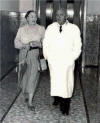
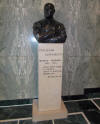

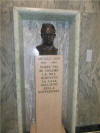

Dr. Guglielmo Sanguinetti (here with his wife
Emilia Spilmann) and Angelo Lupi remembered at the entrance of Casa
Sollievo |
| |

 The hospital
"Casa Sollievo della Sofferenza" (Home for the
Relief of Suffering) today. The hospital
"Casa Sollievo della Sofferenza" (Home for the
Relief of Suffering) today. |
| |
See Padre Pio making a speech at the grand opening of the Casa Sollievo
della Sofferenza |
| |






















Some of the objects displayed in the Museum of Casa Sollievo. |
| |




 The new church inside Casa Sollievo.
The new church inside Casa Sollievo. |
| |

 Mary Pyle was born on April 17, 1888 at 215
West 45th Street in New York City, NY. Mary Pyle was born on April 17, 1888 at 215
West 45th Street in New York City, NY.
On September 15, 1888 she received the Christian Baptism in the Church of
the Covenant (merged with the Brick Presbyterian Church in 1894), as
Adelia McAlpin Pyle. Certificates provided by Pauline Marie Salmon. |
| |
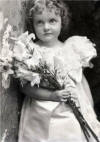 Young Mary in a church play. Young Mary in a church play.
While in Europe in a study trip Mary Pyle met Maria Montessori, the educator who
developed the Montessori Method. She became her assistant and
interpreter. |
| |
|
| |
 This classroom picture was taken in a Montessori school in New York.
The individual in the back of the classroom, from left to right, are
Mario Montessori, Helen Parkhurst, Maria Montessori, and Adelia Mary
Pyle.
This classroom picture was taken in a Montessori school in New York.
The individual in the back of the classroom, from left to right, are
Mario Montessori, Helen Parkhurst, Maria Montessori, and Adelia Mary
Pyle. |
| |
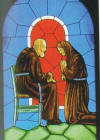 Mary Pyle met Padre Pio on October 4, 1923. He
put his hand on her head and told her: Mary Pyle met Padre Pio on October 4, 1923. He
put his hand on her head and told her:
"My daughter, do not travel
anymore. Stay here." |
| |

 
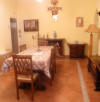
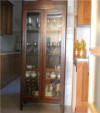 

 
She built a house near the convent. |
| |
 The house has a large sloping front garden.
The house has a large sloping front garden. |
| |

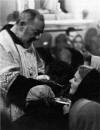 Mary went daily to Padre Pio's
Mass and received the Communion. Mary went daily to Padre Pio's
Mass and received the Communion. |
| |
 She became a member of the Third Order of
Saint Francis. She became a member of the Third Order of
Saint Francis. |
| |
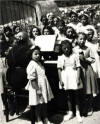 She played the harmonium, directed the choir in
singing, ad organized children in the Christmas play at the convent.
She played the harmonium, directed the choir in
singing, ad organized children in the Christmas play at the convent. |
| |
 She was generous with the pilgrims, the poor, and the friars.
She was generous with the pilgrims, the poor, and the friars. |
| |

 
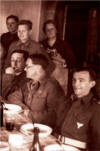
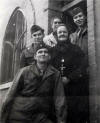

She helped the visiting American soldiers during
WWII anyway she could. |
| |
 Mary Pyle with count Hefner and the two nieces of Padre Pio. Mary Pyle with count Hefner and the two nieces of Padre Pio. |
| |
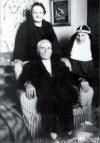 Mary Pyle with Padre Pio's father and the nun sister.
Mary Pyle with Padre Pio's father and the nun sister.
In
December 1929, Mary had taken Mamma Peppa and “zì” Grazio in her home, to San Giovanni
Rotondo so that they could be closer to their son. She cared for them until they died.
Mamma Peppa died of pneumonia on January 3, 1930. "Zi Grazio" died on
July 10, 1946. |
| |
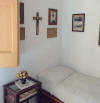


 The bed of Padre Pio's father.
The bed of Padre Pio's father.
 Padre Pio
caring for his dying father at the home of Mary Pyle. Padre Pio
caring for his dying father at the home of Mary Pyle. |
| |
 She met Padre Pio and the other friars frequently.
In the picture Padre Pio is giving advice to Mary Pyle.
She met Padre Pio and the other friars frequently.
In the picture Padre Pio is giving advice to Mary Pyle. |
| |
Convent and church of the Holy Family in Pietrelcina |
| |
 In Pietrelcina a young student Padre Pio, walking
with archpriest Salvatore Pannullo by an area called "Gregaria", "heard
a choir of angels singing, and bells in full peal" and prophesized that
one day a convent and a church would be built, for the sons of St.
Francis in that location. In Pietrelcina a young student Padre Pio, walking
with archpriest Salvatore Pannullo by an area called "Gregaria", "heard
a choir of angels singing, and bells in full peal" and prophesized that
one day a convent and a church would be built, for the sons of St.
Francis in that location.
|
| |
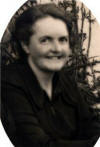 Years
later he told Mary Pyle to build it.
"...and dedicate it to the Sacred Family". So she financed the church of the Holy Family, a
convent and a seminary for the Capuchin students in Pietrelcina. The
construction was completed in 1951. Years
later he told Mary Pyle to build it.
"...and dedicate it to the Sacred Family". So she financed the church of the Holy Family, a
convent and a seminary for the Capuchin students in Pietrelcina. The
construction was completed in 1951. |
| |



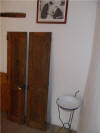
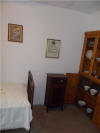
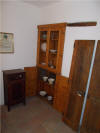
During
the building Mary stayed in Pietrelcina in the same place where Padre
Pio had lived from 1910 to 1916. |
| |



 The
convent and the church of The Holy Family now called the church of Saint
Padre Pio. The
convent and the church of The Holy Family now called the church of Saint
Padre Pio. |
| |

 Statue in front of the convent: young
seminarian friars offer to Padre Pio the model of the convent seminary.
Statue in front of the convent: young
seminarian friars offer to Padre Pio the model of the convent seminary.
|
| |



Inside the church there is a statue of Padre Pio and a reliquary
containing the hyoid bone (it fell off at the time of the recognition of
the body). |
| |
  There
is also the tomb of Fra' Modestino da Pietrelcina. He was from the same
town of Padre Pio and his parents were neighbor of the Forgione family. There
is also the tomb of Fra' Modestino da Pietrelcina. He was from the same
town of Padre Pio and his parents were neighbor of the Forgione family. |
| |
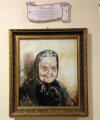 A painting of Mary Pyle remembers her generosity. A painting of Mary Pyle remembers her generosity. |
| |
 Stained window showing Mary Pyle donating the
church and the convent of the Holy Family to Padre Pio. Stained window showing Mary Pyle donating the
church and the convent of the Holy Family to Padre Pio. |
| |

 The Museum near the church contains many objects
used by Padre Pio or related to him.
The Museum near the church contains many objects
used by Padre Pio or related to him. |
| |
Mary Pyle back in San Giovanni Rotondo |
| |
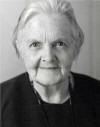
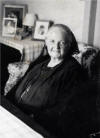 When Mary Pyle returned to San Giovanni Rotondo
from Pietrelcina she continued her generous mission.
When Mary Pyle returned to San Giovanni Rotondo
from Pietrelcina she continued her generous mission. |
| |
 Mary Pyle, with Our Lady of Grace, greets Padre Pio at the entrance
of
Paradise.
Mary Pyle died
on April 26, 1968 in San Giovanni Rotondo.
She is the only spiritual child of Padre Pio featured in the mosaics of
the golden crypt of the new San Pio church. Mary Pyle, with Our Lady of Grace, greets Padre Pio at the entrance
of
Paradise.
Mary Pyle died
on April 26, 1968 in San Giovanni Rotondo.
She is the only spiritual child of Padre Pio featured in the mosaics of
the golden crypt of the new San Pio church.
|
| |
 Part of Mary Pyle's home is currently used as a
center for capuchin vocations.
Part of Mary Pyle's home is currently used as a
center for capuchin vocations. |

 Padre Pio with dr. Sanvico, dr. Sanguinetti
and others.
Padre Pio with dr. Sanvico, dr. Sanguinetti
and others.
 Maria Basilio Venchi, a spiritual daughter,
brought the most part of the land were the future hospital would be
built, and donated it to Padre Pio.
Maria Basilio Venchi, a spiritual daughter,
brought the most part of the land were the future hospital would be
built, and donated it to Padre Pio. Angela Serritelli,
also spiritual daughter, owned the adjacent part of the land needed for
the hospital. She donated it to Padre Pio.
Angela Serritelli,
also spiritual daughter, owned the adjacent part of the land needed for
the hospital. She donated it to Padre Pio.  Barbara Ward was an English
journalist and writer for The Economist. She
met Padre Pio in the early stages of the Hospital. Through her boyfriend
Australian Commander Robert Jackson the UNRRA (United Nations Relief
and Rehabilitation Administration)
on June 21, 1948 provided a
very large sum that made possible the construction of the hospital.
Barbara Ward was an English
journalist and writer for The Economist. She
met Padre Pio in the early stages of the Hospital. Through her boyfriend
Australian Commander Robert Jackson the UNRRA (United Nations Relief
and Rehabilitation Administration)
on June 21, 1948 provided a
very large sum that made possible the construction of the hospital.
 Barbara
Ward (front left) visiting the construction site. Angelo Lupi, who
planned and directed the construction, is at far right.
Barbara
Ward (front left) visiting the construction site. Angelo Lupi, who
planned and directed the construction, is at far right. Barbara
asked Padre Pio to pray for the conversion of her boyfriend. Padre Pio
said "yes" and she replied "when?" Padre Pio:
"Even at this moment if
God wants." She later learned that at that very moment he had converted.
She also asked Padre Pio to pray for her recovery from cancer.
Barbara
asked Padre Pio to pray for the conversion of her boyfriend. Padre Pio
said "yes" and she replied "when?" Padre Pio:
"Even at this moment if
God wants." She later learned that at that very moment he had converted.
She also asked Padre Pio to pray for her recovery from cancer.


 The stained window in the chapel of Casa Sollievo
bears resemblance to Barbara Ward.
The stained window in the chapel of Casa Sollievo
bears resemblance to Barbara Ward. Padre Pio liked the plans drawn by Angelo Lupi,
and he was put in charge of the construction.
Padre Pio liked the plans drawn by Angelo Lupi,
and he was put in charge of the construction. May 19, 1947: Lying of the first stone and
ground braking for the construction of the hospital "Casa Sollievo."
May 19, 1947: Lying of the first stone and
ground braking for the construction of the hospital "Casa Sollievo."




 Padre Pio (in the car) visited frequently.
Padre Pio (in the car) visited frequently.













































 The new church inside Casa Sollievo.
The new church inside Casa Sollievo.



















































